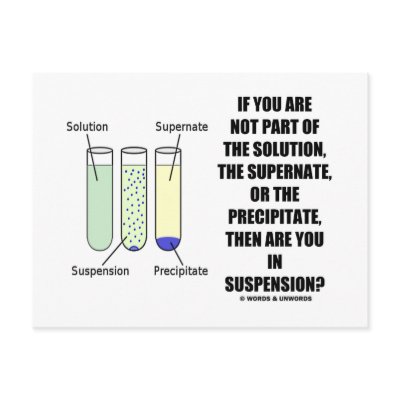Solutions are homogeneous well-mixed mixtures that cannot be
separated easily (a change in phase) - like kool-aid or saltwater.
Suspensions will settle and separate over time because of gravity or
because of differences in density - like oil and water or orange juice
with pulp. Suspensions are heterogeneous. Colloids are weird. Colloids
should settle and separate over time but because the particles are
super-tiny just running into each other (Brownian motion) keeps them in
suspension. Colloids can also represent two different phases so if it
seems weird like you cannot classify it as just one phase - like fog,
jello, whipped cream - it's a colloid.
We
also discussed colligative properties. Adding solutes to a solution
changes basic properties like melting points and boiling points, no
matter what solute is added. A perfect tie-in for today. Salt is put on
our roadways to LOWER the freezing point of water to about -4*C. Because
the freezing point is lowered, the ice appears to melt and stay liquid,
thus making our roads less icy. They do not salt the roads in places
where the normal daily temperature is below 0 because the salt would
have little effect.
Because
it doesn't matter what the solute is, sugar could be used for the same
purpose - it is just a lot more expensive! To read more, click here.
Electrolytes
can conduct electricity because the solute breaks up into ions and the
ions can carry the electric current. Pure water does not conduct
electricity - but water with solutes in it can. We did an in-class demo
similar to this one to test some solutions. Salt water does conduct
electricity, but sugar water does not because of the carbon. Gatorade
conducts electricity but barely because of the high sugar amount in the
drink.
Molarity is moles/Liters and is a
quantitative way to measure concentration. Molarity descirbes with
numbers if a solution is dilute or concentrated. It is a pretty easy
formula so students zoomed through it. Molarity changes with the amount
of solute OR the amount of solvent (liquid) so we will be discussing
dilutions tomorrow.












No comments:
Post a Comment